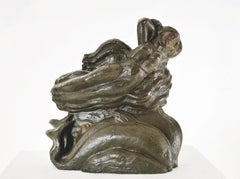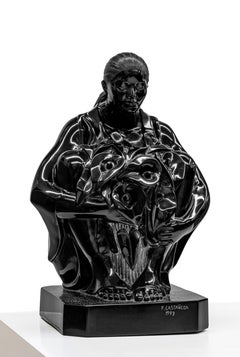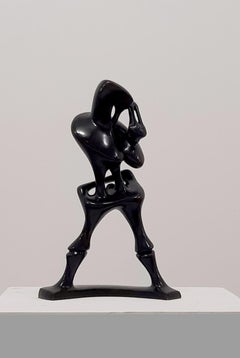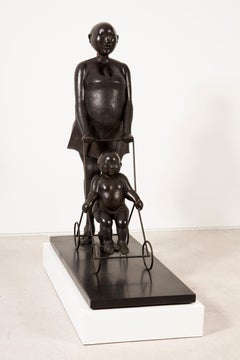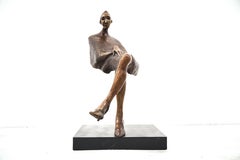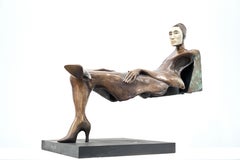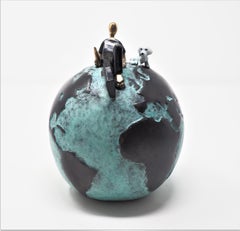Ascaso Gallery Figurative Sculptures
to
1
2
3
2
4
Overall Width
to
Overall Height
to
1
6
5
1
1
3
1
6
1
11
9
8
5
4
3
2
2
1
1
1
1
1
1
11
11
1
1
6
3
1
12
Maqueta las toninas
Located in Miami, FL
Maqueta las Toninas, 1944
BMY-022, 1970
Edition 1/25
Bronze
22 x 22 x 10 cm
8.6 x 8.6 x 3.9 in
ABOUT THE ARTIST
Narvaez was born in Porlamar, Venezuela, in 1905; he was the fifth son of eleven siblings; his parents were Jose Lorenzo Narvaez and Vicenta Rivera. Don José Lorenzo, a multifaceted and creative man, sowed the seed of creativity in his son. “My father did not fit in with his fantasies of cabinetmaker, bricklayer, master builder, and self-taught architect.”1 From an early age, Francis was led to the artistic activity, he traced, carved, made replicas of the furniture and the saints restored by his father.
In 1920 he obtained his first professional assignment, a San Rafael for the Church of Carupano, and, in 1922, his father authorized him to travel to Caracas to pursue his studies as an artist. He studied at the atelier of Marcos Castillo, at of the Angel Cabre y Magriña and at the Academy of Fine Arts in Caracas, where he was introduced to the painters and intellectuals of the time.
In 1928 he presented his first solo exhibition at the Club Venezuela. With the money raised from the sale of the works and the support of Monsignor Sosa, and the Ministers Centeno Grau and Arcaya, he studied in Paris on a scholarship. Once there, he enrolled at the Académie Julian, where Tito Salas, Cristóbal Rojas and Arturo Michelena had also studied. It was in Paris where, unable to work in wood, he turned to stone carving. “In Paris, I didn’t have wood, so I carved a lot in stone (…), when there were demolitions I purchased chunks of stone, I would take them to the workshop and carve them.”2
His first attempts at volumetric sculptures and painting in plain colours, linked to the thematic of American miscegenation and Creole reality, can be traced back to that first trip to Paris. During his stay in the French city, Arturo Uslar Pietri, Alfredo Boulton, and Finita Vallenilla supported the artist both financially and logistically, and in February of 1930, the trio of friends arranged another exhibition for him at the Club Venezuela. Narvaez describes his exhibition as follows: “(…) in it I feel that the sculptural work is more my own, done with more assurance, a response to my pursuit of large planes, stylisation and synthesis.”3 By then, as Boulton himself noted in his book about the artist, Narvaez departed from most of the artistic traditions that prevailed by that time in Venezuela.
In 1931 he returned to Caracas and established his atelier at the Barrio Obrero in Catia. The atelier became the hub of the intellectual life of the time. “In those years, the atelier of Francisco Narvaez was the hub of the greatest Venezuelan hope. Nothing comparable to it can be found either before or since.”4
From that year onwards, exhibitions, projects, trips, and awards we multiplied. He was awarded the President of the Republic of Venezuela Prize, the National Sculpture Prize of the 1st Official Venezuelan Art Salon, and the John Boulton Prize of the 3rd Annual Venezuelan Art Salon; for the Military Academy, he produced a spectacular relief entitled La Patria.
In 1945, commissioned by the architect Carlos Raúl Villanueva, he produced two groups of sculptures known as Las Toninas, both located in the O’Leary Square. There, as he himself states, he incorporates some baroque patterns into the figures to the source itself: “It is a work of balance between the decorative requirements and the sculpture of planes and angles.”5
In 1948 he was awarded the National Painting Prize. In the same year, he was called upon by the architect Carlos Raul Villanueva to participate in the project for the arts integration in the Universidad Central de Venezuela. Francisco Narvaez’s public output continued with works such as the statue of Fermín Toro, La Educacion, La Ciencia, three murals (produced by María Luisa Tovar) for the Instituto de Medicina Experimental, El Cristo; el Atleta, the equestrian statue of General Rafael Urdaneta.
In 1953 he was appointed Director of the School of Plastic and Applied Arts, and in July of the same year, he exhibited “Francisco Narvaez, Maderas, Piedras y Bronces” (Francisco Narvaez, Woods, Stones and Bronzes) at the Museum of Fine Arts.
Narvaez is, unquestionably, one of the great Venezuelan sculptors, his work goes through various stages and interests; as the art world evolves, the artist does not remain in his initial scopes of work. His creations are not imposed by the prevailing trends or fashion but do evolve by experimenting with new materials and interests.
When one peruses the artist’s lengthy list of exhibitions, commissions, and awards, it is worth remembering the Narvaez who embark on his career as a child and who, overcoming obstacles, knew how to make the most of his curiosity. He did not settle for living off his successes. He did not remain stagnant as many creators of his environment did. Narvaez managed to understand the changes in the history of art around him. We must not overlook the fact that Francisco Narvaez is an artist amid all the changes occurring in the art world. He moves from the classics to the great transformations in the art world. It is the Europe of Picasso, Braque, Arp. He observes, he is aware of what is happening in the centres of the world of art, but between his craft and his sensitivity, the result is NARVAEZ, his stamp, and his identity.
Francisco Narvaez comes from tradition, and his first stage is linked to the classics, to the exploration of his heritage, but always with his very own language. Throughout his prolific career, he knew how to remain true to himself, without disregarding the influences of his surroundings or his artistic interests: his ability as a sculptor, his selection of materials, whether they were wood, stone or bronze; his choice of the subject of his work…His mastery and great craftsmanship are a constant that over time have made him a leading player in the history of contemporary Venezuelan and world art.
From his beginnings, no subject was foreign to him. His paintings, drawings, aquarelles, and sketches are testimony to his prolific output. Among his themes are portraits, our traditions, still lifes, and landscapes. Narvaez is an artist who represents his time. Later, he evolved towards purer and simpler forms, abandoning figurative art for short periods.
In 1956 he declared to the newspaper El Nacional: “Every day I am freeing myself, it is a soul that frees itself from the ephemeral wrappings of the circumstantial always, as well as from the inevitable weight of the anecdote. This second stage of my work is remarkably close to abstractionism, even if there are still certain figures or figurations in the sculptures that I will shortly be showing. However, pure, and absolute abstractionism, it will treat the form itself as the sole reason for its existence on the plane of artistic excellence.”6
The artistic development was his professional life. Each period of his life as an artist, he went one step further, searching, solving, seeing plenty of things and understanding how diverse expressions were transforming themselves. His hands followed his gaze and his mind, always inquisitive. He added movement to the volumes.
Arturo Uslar Pietri, “Formas Nuevas”, Cromotip editions, 1956 “Francisco Narvaez is a path: the path that Venezuelan sculpture...
Category
1940s Baroque Figurative Sculptures
Materials
Bronze
Felipe Castañeda, Mujer con Flores, 1982, Black Marble, 20.4 x 12.5 x 13.7 in.
By Felipe Castañeda
Located in Miami, FL
Felipe Castañeda
Mujer con Flores, 1982
Black Marble
52 x 32 x 35 cm
20.4 x 12.5 x 13.7 in.
Felipe Castañeda (Mexican, b.1933) began his artistic ca...
Category
1890s Post-War Figurative Sculptures
Materials
Marble
Agustín Cárdenas, El Violinista, Bronze, Edition 4/6, 1983, Small size
By Agustín Cárdenas
Located in Miami, FL
Agustín Cárdenas
El Violinista, 1989
Bronze. Ed. 4/6
54 x 36 x 22 cm
21.2 x 14.1 x 8.6 in.
AGUSTIN CARDENAS
(b. 1927, Matanzas, Cuba; d. 2001 Havana,...
Category
1980s Futurist Figurative Sculptures
Materials
Bronze
Cornelis Zitman, Divertimiento, 1973, Bronze, 72 x 34 x 45 cm
Located in Miami, FL
Cornelis Zitman
Divertimiento, 1973
Bronze, AP
72 x 34 x 45 cm
28.3 x 13.3 x 17.7 in.
Cornelis Zitman (1926-2016)
Born in Leiden in a family of builders, he enters the Fine Arts ...
Category
1970s Figurative Sculptures
Materials
Bronze
Jorge Seguí, Ilusion silla, 2000, Bronze, Edition of 7, 78 x 90 x 33 cm
By Jorge Seguí
Located in Miami, FL
Jorge Seguí
Ilusion silla, 2000
Bronze, Edition of 7
78 x 90 x 33 cm 30.7 x 35.4 x 12.9 in.
Signed and Numbered.
Jorge Seguí b. 1945, Argentina. He atte...
Category
Early 2000s Contemporary Figurative Sculptures
Materials
Bronze
Jorge Segui Magic Woman, 2019 Bronze. 1/3 AP
By Jorge Seguí
Located in Miami, FL
Jorge Segui
Magic Woman, 2019
Bronze. 1/3 AP
83.8 x 91.4 x 59.6 cm 33 x 36 x 23.5 in.
Signed and Numbered.
Jorge Seguí b. 1945, Argentina. He attended th...
Category
2010s Contemporary Figurative Sculptures
Materials
Bronze
Price Upon Request
Jorge Seguí, Falsos Heroes en Caballos Míticos, 2010-2013, Bronze, Edition 1/7
By Jorge Seguí
Located in Miami, FL
Jorge Seguí
Falsos Heroes en Caballos Míticos, 2010-2013
Bronze, Edition 1/7
110 x 71 x 70 cm 43.3 x 27.9 x 27.5 in.
Signed and Numbered.
Jorge Seguí b...
Category
2010s Contemporary Figurative Sculptures
Materials
Bronze
Agustín Cárdenas, Le Repos Passionné, 1989, Bronze. Edition 7/7
By Agustín Cárdenas
Located in Miami, FL
Agustín Cárdenas
Le Repos Passionné, 1989
Bronze. Ed. 7/7
60 x 145 x 51.5 cm 23.6 x 57 x 20.2 in.
The artwork is accompanied by a certificate of aut...
Category
1980s Futurist Figurative Sculptures
Materials
Bronze
Agustín Cárdenas, El Violinista, Bronze, Edition 3/3, 1989, Big size
By Agustín Cárdenas
Located in Miami, FL
Agustín Cárdenas
El Violinista, 1989
Bronze. Ed. 3/3
177 x 120 x 61 cm 69.6 x 47.2 x 24 in.
AGUSTIN CARDENAS
(b. 1927, Matanzas, Cuba; d. 2001 Havan...
Category
1980s Futurist Figurative Sculptures
Materials
Bronze
Jorge Seguí, Esperansilla, Bronze, Edition 1/7, 2003
By Jorge Seguí
Located in Miami, FL
Jorge Seguí
Esperansilla, 2003
Bronze, Edition 1/7 + 3AP
71.1 x 40.6 x 30.4 cm 28 x 16 x 12 in.
Signed and Numbered.
Jorge Seguí b. 1945, Argentina. He a...
Category
Early 2000s Contemporary Figurative Sculptures
Materials
Bronze
Price Upon Request
Jorge Seguí, Ciclista IX, Bronze, Edition 7/7, 1990-1995
By Jorge Seguí
Located in Miami, FL
Jorge Seguí
Ciclista IX, 2010-13
Bronze, Edition 7/7
70.5 x 18 x 70 cm 27.7 x 7 x 27.5 in.
Signed and Numbered.
Jorge Seguí b. 1945, Argentina. He attend...
Category
1990s Contemporary Figurative Sculptures
Materials
Bronze
Price Upon Request
Jorge Seguí, Falsos Heroes en Caballos Míticos, Bronze, Edition 1/7, 2010-2013
By Jorge Seguí
Located in Miami, FL
Jorge Seguí
Falsos Heroes en Caballos Míticos, 2010-13
Bronze, Edition 1/7
110 x 71 x 70 cm 43.3 x 27.9 x 27.5 in.
Signed and Numbered.
Jorge Seguí b. 19...
Category
2010s Contemporary Figurative Sculptures
Materials
Bronze
Related Items
The Rape of Sabine Iconic Bronze Sculpture 1930
Located in Rome, IT
Fine Group of Sculptures in Bronze after Jean de Boulogne (Giambologna)
The torturously twisting Rape of the Sabine Women is one of the finest and most technically difficult sculpt...
Category
1920s Mannerist Figurative Sculptures
Materials
Bronze
$6,697 Sale Price
30% Off
H 35.44 in W 8.27 in D 8.27 in
"Laid Back" figurative bronze table sculpture dog relax carefree boy enjoy life
By Mireia Serra
Located in Kowloon, Hong Kong
When was the last time you broke yourself from the hustle and bustle of the daily routine, spent quality time with yourself and enjoyed the ease of mind and soul?
"Our lives are com...
Category
2010s Contemporary Figurative Sculptures
Materials
Bronze
$3,575
H 7.09 in W 5.91 in D 5.91 in
Davinci's Horse Rears by Helle Crawford, Bronze sculpture of a horse
By Helle Rask Crawford
Located in DE
Bronze sculpture of a horse that rears on granite base
Category
21st Century and Contemporary Contemporary Figurative Sculptures
Materials
Granite, Bronze
$1,052
H 8.67 in W 5.52 in D 2.37 in
Yves Klein Dying Slave After Michelangelo IKB Sculpture Bright Klein Blue
By Yves Klein
Located in Paris, FR
Yves Klein, Dying Slave after Michelangelo
IKB blue resin in plexiglas, signed Rotraut Klein Moquay and numbered 224/300 on the base on a label.
300 editions numbered from “1/300” to...
Category
1990s Post-War Figurative Sculptures
Materials
Resin, Plexiglass
$107,630
H 26.38 in W 12.6 in D 9.85 in
Il Trovatore, Chirico, Multiples, 1970's, Bronze, Sculpture, Surrealiste
By Giorgio De Chirico
Located in Geneva, CH
Il Trovatore, Chirico, Multiples, 1970's, Bronze, Sculpture, Surrealiste
Il trovatore
Ed. 250 pcs
1971
Bronze with silver patina
H. 31 cm
Signed and date...
Category
1970s Post-War Figurative Sculptures
Materials
Bronze
$16,313
H 12.21 in W 1.97 in
Scène de Tauromachie, Picasso, Edition, 1950's, Bull, Plate, Design, Animal
By Pablo Picasso
Located in Geneva, CH
Scène de Tauromachie, Picasso, Edition, 1950's, Bull, Plate, Design, Animal
Scène de tauromachie
Ed. 193/500 pcs
1957
Red earthenware clay, engobe decoration, knife engraved
D.24 cm...
Category
1950s Post-War Figurative Sculptures
Materials
Ceramic, Earthenware, Terracotta
$13,394
H 9.45 in Dm 1.19 in
Bronze of Pluto Abducting Proserpine after François Girardon
Located in New Orleans, LA
After François Girardon
1628-1715 French
Pluto Abducting Proserpine
Bronze
This High Baroque period composition captures the famed narrative of Pluto and Proserpine from Roman mythology. The late 17th-century patinated bronze, created after François Girardon's marble composition, captures the very moment that Pluto seizes Proserpine. The anguished goddess reaches skyward, attempting to escape the god’s grasp while Pluto’s stoic face betrays his knowledge that his ploy will succeed. This pivotal moment in the mythological tale has captured the imagination of many art historical greats, from Bernini to Rubens. François Girardon’s version of the climax demonstrates incredible finesse and artistry, modeled expertly in bronze in the present work by a later sculptor. The statue brings a twist of intertwined bodies into a dynamic frenzy, paralleling the tension of the legendary story.
In ancient Roman mythology, Proserpine, the beautiful daughter of Ceres — known as Persephone in Greek mythology — was picking flowers in the fields when she was suddenly abducted by Pluto, the god of the underworld, and taken to his kingdom. Consumed with grief, her mother Ceres, the goddess of agriculture, scorches the earth, stopping the growth of grain and fruit. Jupiter attempts to intervene and secure Proserpine’s return to earth, negotiating a compromise with Pluto and the Fates that allows Proserpine to be released for part of the year before returning to Pluto’s underworld. Proserpine’s journey back and forth is an allegory for the changing seasons; when Prosperine is with her mother, the earth warms and provides bountiful harvests. Upon her annual return to the underworld, however, the earth once again becomes cold and barren.
After returning to France after years of training in Rome, François Girardon quickly rose to become one of the greatest artists in France. He was elected a member of the Académie Royale de Peinture et de Sculpture in 1657 and would become Chancellor of the Royal Academy in 1695. The artist was approached frequently for royal commissions and Girardon’s Pluto was originally commissioned by Louis XIV for the gardens at his Palace of Versailles. It was one of four monumental marble groups intended to decorate the corners of Charles Le Brun’s never completed garden at the chateau, the Parterre d’Eau. Each group of three figures symbolized one of the four elements: earth, air, fire and water. Pluto’s association with hell made him the apt...
Category
Early 18th Century Baroque Figurative Sculptures
Materials
Bronze
$78,500
H 21.25 in W 11.25 in D 10.25 in
Tête de Faune, Picasso, Unique work, 1960's, Terracotta, Tiles, Design, Sculptur
By Pablo Picasso
Located in Geneva, CH
Tête de Faune, Picasso, Unique work, 1960's, Terracotta, Tiles, Design, Sculptur
Tête de faune
Unique work
14.03.1961
Painted and glazed terracotta tile...
Category
1960s Post-War Figurative Sculptures
Materials
Terracotta
$124,127
H 5.91 in W 5.91 in D 0.6 in
Baroque Venetian sculptor - Pair of 17th century lions wood sculptures
Located in Varmo, IT
Pair of bookend sculptures. Venice, 17th century.
15 x 15 x h 29 cm.
Entirely in finely carved wood.
- This item is sold with a certificate of authenticity with legal validity.
-...
Category
Early 17th Century Baroque Figurative Sculptures
Materials
Wood
$2,364 Sale Price
20% Off
H 5.91 in W 5.91 in D 11.42 in
Rare and Important Italian Alabaster Bust Sculpture of Jesus Christ, C. 1860
Located in Queens, NY
A rare and important Italian alabaster bust sculpture of Jesus Christ, C. 1860
A modeled bust of Holy Christ wearing a crown of thorns, exceptional...
Category
19th Century Baroque Figurative Sculptures
Materials
Alabaster
$110,000
H 21 in W 11 in D 4 in
Pair of 19th Century Busts by Albert Ernest Carrier-Belleuse
By Albert-Ernest Carrier-Belleuse
Located in Santa Fe, NM
Signed: A. Carrier-Belluese
Two large bronze matching busts of an unknown male and female
22 x 10 x 11" male
23 x 10 x 9" female
Both show signs of wear with their age but are in fa...
Category
19th Century Baroque Figurative Sculptures
Materials
Marble, Bronze
$6,000 Sale Price
50% Off
H 23 in W 22 in D 10 in
Baroque Roman sculptor - 17th century bronze sculpture - Mars Warrior
Located in Varmo, IT
Gilded bronze sculpture - Mars, god of War. Rome, 17th century.
9 x 9 x h 31 cm.
Entirely in cast, chiseled and gilded bronze, resting on an ebonized wooden pedestal decorated with...
Category
Mid-17th Century Baroque Figurative Sculptures
Materials
Bronze
$4,137 Sale Price
41% Off
H 12.21 in W 3.55 in D 3.55 in
